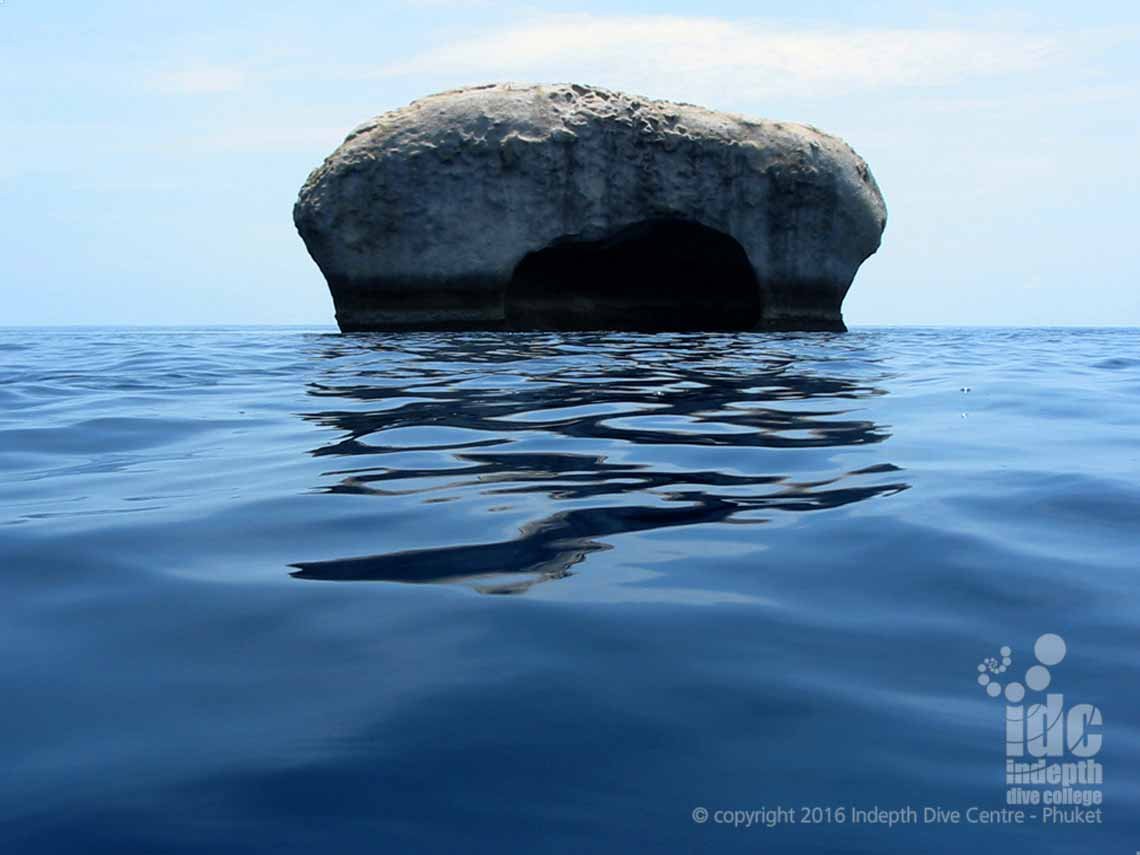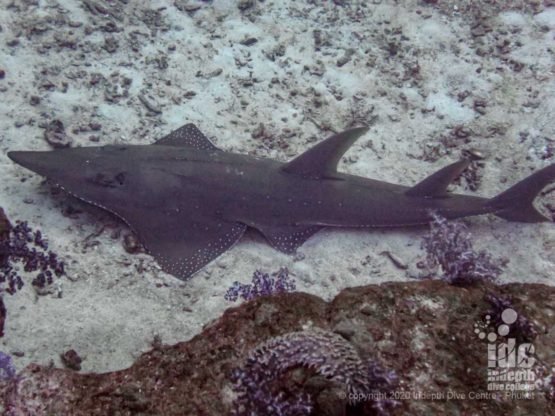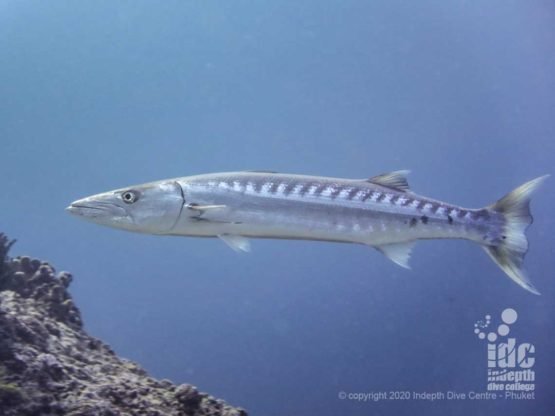
Similan Islands No. 7-8: Elephant Head Rock / Hin Pusa
Elephant Head Rock, or Hin Pusa as it is locally known, is located in open water approximately 1km South West of Island No. 8. And Elephant Head Rock is probably the most famous dive site in the Similan Islands. Probably next only to Richelieu Rock in the Surin Islands.
On the surface, it is made up of 3 huge granite boulders which break the surface. However the most Easterly of the 3 is said to look like an Elephant’s Head. Hence the dive site name Elephant Head Rock. Elephant Head is a collection of large boulders with a good selection of Hard and soft corals. In addition it is covered in Sea Fans flourishing in the rich water currents. These can make quite a powerful back drop for underwater photographers.
This can be a “challenging” dive site, especially when the currents are at their strongest, around full and new moon. In addition, as Elephant Head Rock is also a deep dive site going to down to 50m+. Consequently it’s recommended that Elephant Head Rock is your 1st or 2nd dive of the day. Known not only for it’s swim-throughs, passageways and sharks, but also for it’s spectacular soft corals, Elephant Head Rock will not disappoint you. You will want to be at you diving best for Richelieu Rock, so feel free to contact us and dive Phuket on one of our Scuba Diving Day Trips before you Similans & Surin Liveaboard Trip!
And with the number of Manta Rays and Whale sharks every year, Elephant Head Rock is an absolute must ...


Is Elephant Head Rock the best Similans Dive Site?
It could well be ...
Elephant Head Rock can be easily identified by the three large granite rocks breaking the surface, with the dive site name supposedly coming the Eastern most of those 3 boulders supposedly resembling the head of an elephant. However the Thais have another name for Elephant Head Rock, which loosely translates to mean ‘Skull Rock’, which is much easier to believe as said rock does indeed look like the top of a skull breaking the surface of the water.
Scuba Divers typically enter the water to the South of the largest rock at Elephant Head Rock. And as there’s no mooring line it is a free descent to around 25m and you should be ready to go down as soon as you get into the water, or you can be pulled off Elephant Head by the current.
When you descend there is often a large school of Bannerfish in the mid-water, If you then head East at a depth of between 15-20m you will reach a large boulder. Go around this and you will enter the “channel”. Entrance is around 18m deep and approximately 20m long. In the channel you can find Gobies, Peacock Mantis Shrimps and occasionally a Rock Mover Wrasse. The channel goes up slightly, around16m, and then drops down to about 20m at the end.
The famous Rock Window
At the end of the channel there is a hole in the rock, surrounded by Sea Fans and soft corals. This is known as “The Window” and is an awesome Elephant Head Rock photo opportunity. Elephant Head Rock is a very popular photo site so make sure to tell your Dive Guide if you want one taken. They will be able make sure that you get a photo for Face Book and your Thailand holiday memories.
As you exit the channel at 20m you will find yourself in an open sandy area. Here you can find many species of Gobies including the Red Fire Gobies and Purple Fire Gobies. Please note however, the Purple Fire Gobies are often very deep. As such you should be aware of your dive time and no decompression limits at all times. You can also find McCosker’s Dwarf Wrasse in this area of the dive site.
Elephant Head Rock is very deep and drops off to 50m+ in this area. In the deeper waters of Elephant Head Rock, you can often find White Tip Reef Sharks hunting across the sands. However, be careful as away from the dive site, the water does drops down to 50m+. However Elephant Head Rock is one of the best dive sites in the area to find several of these Sharks together.
The epic swim-throughs
Elephant Head Rock is well known for its many swim-throughs. These range from 5m to more than 35m. These are large passageways with plenty of light and you do not need a torch to go through them. However, it is recommended you go through in single file. Please remember not to swim too close to the diver in front as you can get “surge” in the swim-throughs.
This is also known as the “Washing Machine” effect.
In the passageways you can normally find Oriental Sweetlips, Rabbit fish and Big Eyes. In addition to some interesting species of Nudibranchs and Cowries. Over the top of the rocks we often see the resident Great Barracuda, who is well used to divers. We first dived with “him” in 1999 and he generally allows you to get close enough to take some good photos.
Rebreather divers usually want to make at least 2 dives here as there is simply so much to see and do here. And that is without anything “special” appearing on the dive! However rebreather divers please do be careful of your depth as it is very easy to get “carried away” here and find yourself way too deep. And divers have even been known to get “lost” if they stray too far away out on the sand.
When you enter this first swim-through you head straight for around 25m. After that turn right for another 20m before exiting at around 21m.
Heading East on Elephant Head Rock
To the East approximately 20m from the exit, there is another smaller swim through at 25m. There are many Sea Fans and Soft Corals around this swim-through. It is small so please watch your buoyancy at all times.
You exit this swim-through on the Eastern edge of the dive site. Don’t forget to keep looking out into the blue now and then. It is “out in the blue” that you will see the Sharks, Rays and “The Big Stuff.” Which whilst rare here, it is not impossible to see the big Pelagic Fish such as Whale Sharks & Manta Rays at Elephant Head Rock!
If you head West, back towards the exit of swim-throughs there is yet another swim-through entrance. This one is at 20m and goes upwards to an exit at 16m. You exit into the centre of the dive site which is a large flat sandy area around 20-25m. In the sand, you can see Garden Eels, Blue Spotted & Kuhls Stingrays and many species of Gobies.
In the middle of this sandy area there are some small boulders. Here you can usually see Giant Moray Eels and Octopus. Heading North East across the flat Sandy area you reach some more large boulders. There is a very nice swim though at 27m, if you have the dive time and enough air left to dive it. After that we then head back East again to the main dive site where it gets shallower. In the mid-water you can expect to see Barracuda, Tuna, Bluefin and Giant Trevally. Along with some Rainbow Runners, Snappers and Fusiliers.Whilst very rare you can sometimes find Frog Fish & Ornate Ghost Pipe Fish on this dive site.
How to end a dive at Elephant Head Rock
There are many other small swim-throughs between 5-30m and you can have great fun exploring between the boulders. And when there is a strong current you can normally get protection from the rocks, just follow your experienced Dive Guide. You normally end the dive at the Northern side of the large rock. Remember it‘s well worth looking in the large crack in the main rock around 8m, as there’s a lot of marine life in here. Believe it or not we sometimes find some Juvenile White Tip Reef Sharks.
When ending the dive it's best to swim away from the rocks during your safety stop. This way it is easier for your dive boat to pick you up.
Elephant Head Rock is a great dive site, one of the best in the Similans Islands. However dive with caution, especially when you are expecting a strong current ...












